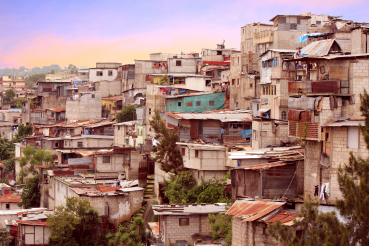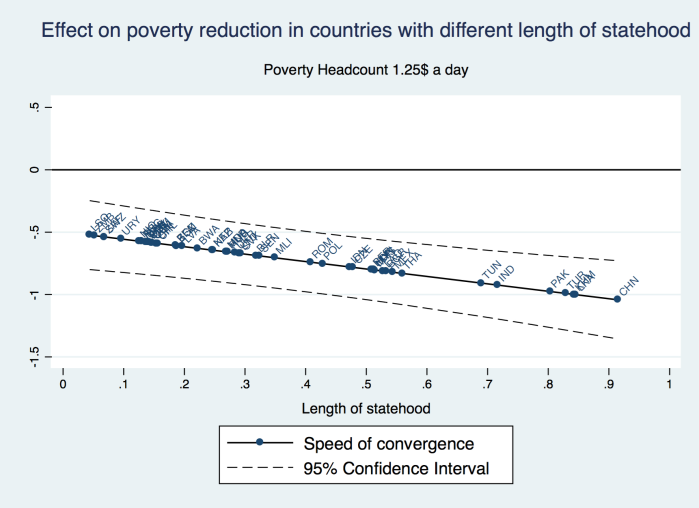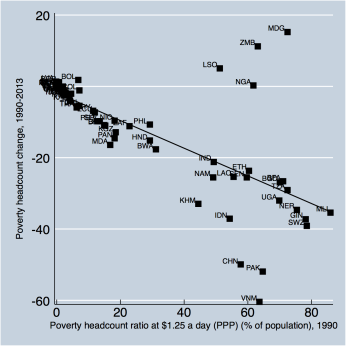Researching the politics of development
Blog

Effective states reduce poverty faster


10th October 2018
Antonio Savoia and M. Niaz Asadullah
Can poverty be eradicated is the biggest question for development. Progress in poverty reduction was a central success with the Millennium Development Goals (MDGs): estimates suggest that as many as one billion people were lifted out of poverty. Since poverty reduction remains important for the more ambitious Sustainable Development Goals (SDGs), it seems that the time is right to identify why poverty has been reduced so much and why some countries have seen a greater reduction than others.
Our research presents new evidence on what facilitates poverty reduction. We find that in more effective states, or in countries with greater state capacity, income poverty has been reduced at a significantly faster speed, and those countries are much more likely to achieve MDG 1 of halving poverty. Our estimates suggest that countries with the highest state capacity can reduce income poverty at up to twice the speed of countries with the weakest capacity.
Our methodology is straightforward. We examine poverty in 89 developing countries between 1990 and 2013. Then, we show whether, and how fast, economies with higher income poverty levels experienced larger reductions in their poverty rates to close the gap with economies with lower income poverty levels – known as poverty convergence. We do this by using such standard international measures as poverty headcount and poverty gap at USD 1.25 and USD 2 per day. Our findings show that these poverty measures tended to decrease faster in countries with initially higher poverty levels.
Does adopting the MDGs explain this convergence? Our research examines whether the convergence process accelerated after 2000. We find that it did, after accounting for outliers. The adoption of the MDGs was a boost for poverty reduction. This presumably reflects the pressure on individual countries to design and implement poverty reduction programmes. Poverty Reduction Strategy Papers, for example, became routine parts of national development plans.
What remains unexplained is the substantial variation in poverty reduction performance across countries. Although at similar levels of initial poverty, some countries present substantial variations in their poverty reduction achievements (Figure 1). Compare the following two groups of countries: Nigeria, Lesotho, Madagascar and Zambia versus China, Vietnam, Indonesia and Cambodia. Initial headcount ratios at USD 1.25 per day were similar in both groups. Yet, the latter group – not the former one – succeeded in reducing poverty.
Figure 1. Initial level of poverty vs. subsequent change: headcount measures
Source: Asadullah and Savoia (2018) “Poverty reduction during 1990–2013: Did millennium development goals adoption and state capacity matter?”, World Development, Volume 105, Pages 70-82.
So what’s causing this disparity? Could it reflect differences in governance conditions at national levels, such as state capacity?
State capacity is greater when ruling elites are subject to more limits on the exercise of their power. Executive power is constrained by institutionalised checks and balances. State capacity is also greater in countries with a longer history of statehood. In these cases, countries’ ability to resolve coordination failures and to deliver goods and services to their citizens is boosted through the effects of learning by doing.
The evidence is not significant that constraints on the executive accelerate poverty reduction. However, the evidence is strong that countries with a longer history of statehood and greater ability to administer their territories experience faster income poverty reduction. These countries were more likely to have achieved the MDG target of halving poverty. The convergence parameter in the group of countries with the longest state history – China, Cambodia, Indonesia, Vietnam and Turkey – is estimated to be approximately double the size of that for the group – Lesotho, Zambia, Zimbabwe and Swaziland – with the shortest state history (Figure 2).
Figure 2. Speed of convergence at different levels of state capacity:
headcount USD 1.25
Source: Asadullah and Savoia (2018) “Poverty reduction during 1990–2013: Did millennium development goals adoption and state capacity matter?”, World Development, Volume 105, Pages 70-82.
Thus, in short, the MDGs were instrumental to poverty reduction, and states with a greater ability to administer their respective territories experienced significantly faster poverty reduction.
So, what are the implications of these findings? First, institutional context matters for poverty reduction. The adoption of new development goals per se, however ambitious, may not be enough. The goals should be coupled with sufficient capability for designing and delivering poverty reduction strategies. Second, as the quality of government is now a part of SDG 16, our results provide empirical justification for this inclusion. It suggests that synergies amongst development goals could be important to further development progress and convergence in living standards during this era of the SDGs.
This post was first published on the OECD blog Development Matters here
Read the research that this blog was based on here


